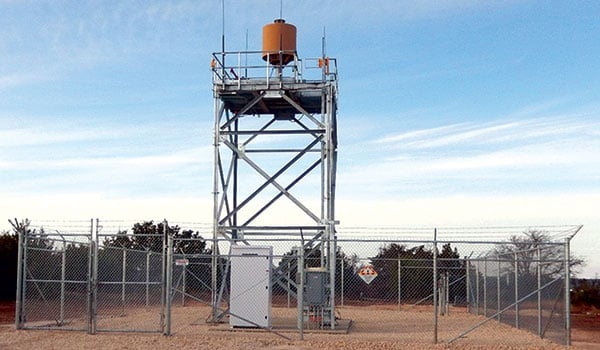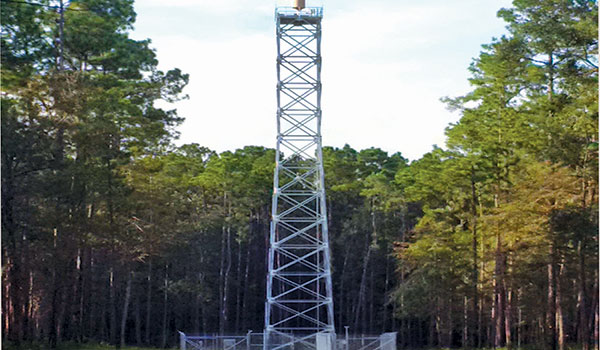
AMRDEC Tech Talk / By Mr. Mike Foley and Mr. Adam Hendrickson: The Army’s Unmanned Aircraft Systems (UAS) Project Office is leading the way towards full integration of UAS into the National Airspace System (NAS) with the Aviation Engineering Directorate (AED) serving as the Airworthiness Authority.

GBSAA installation at Fort Hood, Texas/PMO UAS COURTESY PHOTOS
Since UAS do not have an on-board pilot looking through a cockpit window to “See and Avoid” other aircraft, an alternate means of compliance to this critical Federal Aviation Regulation (FAR) is required. Ground Based Sense And Avoid (GBSAA) provides the missing airspace awareness to UAS operators on the ground, allowing them to “Sense and Avoid” other aircraft. This capability will allow UAS to safely operate with greater flexibility. Current UAS operations require the use of ground observers or chase aircraft in order to prevent potential conflicts with other aircraft. GBSAA removes the need for ground observers and chase aircraft as airspace awareness is provided by the system. GBSAA can also support night operations where it is difficult for ground observers to determine relative distances.
The current GBSAA system is designed to support operations in a variety of airspace. Initial operations will support transits between airfields in Class D airspace and military restricted airspace where the majority of UAS training operations currently occur. Because military restricted airspace is often crowded and shared with other military users, GBSAA will enable training in other airspace such as Military Operating Areas (MOAs).
GBSAA fulfills a vital training need by helping to maintain UAS readiness levels. It provides greater flexibility for when and where UAS training can be accomplished. As sense and avoid capabilities continue to grow, the manner in which UAS are used and how they are teamed with manned aviation will evolve. Future sense and avoid capabilities will allow for greater flexibility in flight, leading to dynamic operations and new mission capabilities. These capabilities may include flight formations with manned aviation, flight following, and other unique military operations.
How it Works
The GBSAA system creates a fused air picture by integrating up to six ground radars. Also, the sensor network includes feeds from air traffic control radars and GBSAA organic radars. The organic radars are specifically tailored for GBSAA operations and designed to track a wide variety of general aviation aircraft including aircraft that may not be visible to air traffic control. Capabilities include three dimensional tracking of slower aircraft, such as ultralights, which may not be equipped with transponders or even a radio. After passing through a classifier that filters out birds and ground vehicles, the fused air picture is processed by alerting algorithms. The alerting algorithms send alerts to redundant GBSAA displays. A GBSAA operator monitors the air picture and receives alerts in time to prevent potential conflicts with other aircraft.

GBSAA installation at Fort Stewart, Georgia
The Army’s GBSAA system uses a redundant design which allows a controlled degradation of capability if a component fails. There are other subsystems which work in the background to monitor the health and integrity of the system, and an alert is issued to notify the operator if any portion of the system is inoperative. This allows the UAS operator to return to a safe state.
The GBSAA system is currently planned to support Gray Eagle UAS operations at five Army locations with operations beginning in 2016. GBSAA organic radars are currently installed on towers at Fort Hood, TX and Ft. Stewart, GA. Radar tower installation is complete at Ft. Riley, KS and will be completed at Ft. Campbell, KY before the end of 2015. Ft. Bragg, NC will be the fifth Army GBSAA location. The program is also on contract with the Air Force and the Air National Guard to provide GBSAA systems to support Global Hawk and Reaper UAS operations.
Mr. Mike Foley is an engineer in the Aviation Engineering Directorate of the U.S. Army Aviation and Missile Research, Development, and Engineering Center and Mr. Adam Hendrickson is an Engineer with the Unmanned Aircraft Systems Project Office; both located at Redstone Arsenal, AL.










